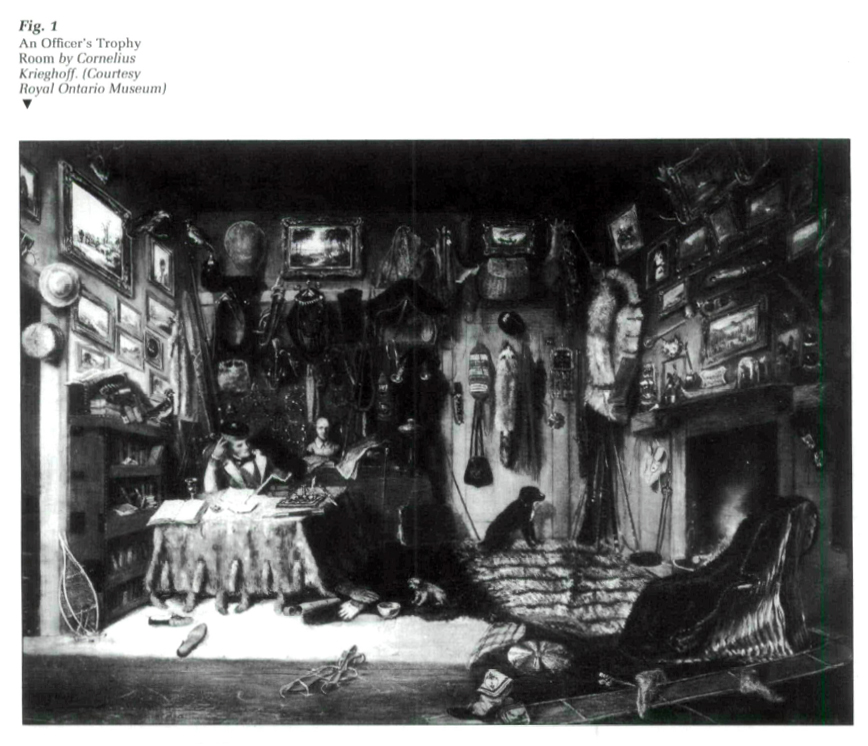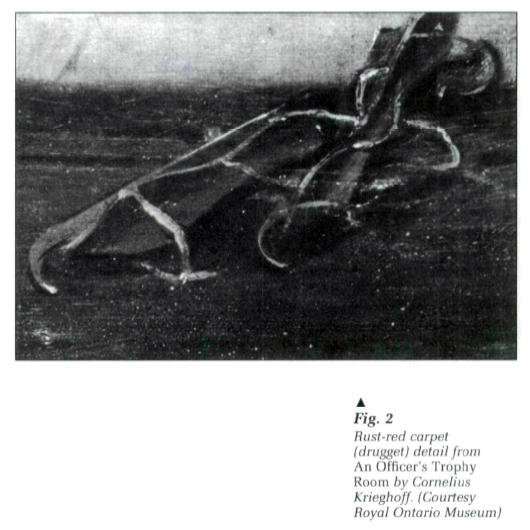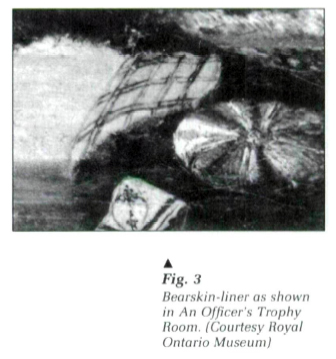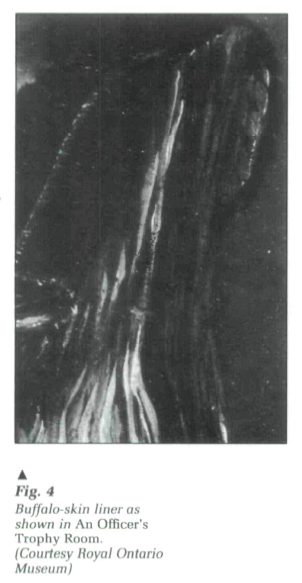Research Reports / Rapports de recherche
Reproducing Textiles for the Krieghoff Room at the Canadian Museum of Civilization
1 In June 1989 I was approached by a representative of the Canadian Museum of Civilization with an unusual request. Would I be able to identify, and weave reproductions of, the types of fabrics in a photographic reproduction of a painting by Cornelius Krieghoff entitled An Officer's Trophy Room, painted in 1846. I have been a full-time professional weaver for the past 15 years and eagerly rose to the challenge. A number of years ago I did a lot of research on eighteenth to nineteenth century Canadian textiles and wove reproduction pieces for sale.
 Display large image of Figure 1
Display large image of Figure 12 The painting depicts a British officer who lived near Chambly, Quebec, at his desk surrounded by his personal belongings and collections. The Canadian Museum of Civilization was to furnish one of the exhibit areas in its History Hall to resemble this painting.
3 There are a number of textiles portrayed in Krieghoff's painting, including a red blanket-like backdrop on the rear wall, a red table covering, a rust-red carpet on the floor in the foreground, plaid liners for some animal skins on the floor and couch, and a floor cloth behind the carpet.
4 Technical research on the rust-red carpet started with the obvious source—"Keep Me Warm One Night:" Early Handweaving in Eastern Canada by Dorothy Burnham. The carpet in the photograph—rust red with indigo stripes—was probably a warp faced carpet, also known as Venetian carpeting and better known in the Maritimes as drugget. Most of these types of carpets were wool warp, closely sett and cotton weft. ("Sett" is a technical term in weaving designating the cloth density expressed as end per inch or centimetre—"epi" or "epc")
5 The English use of the word drugget is not to be confused with the eighteenth century term droguet, which is a figured silk fabric with small pattern units formed by both warp and weft threads and used widely for men's and women's clothing. Drugget carpets were used extensively in the eighteenth and nineteenth centuries as a lining or protective covering for other carpets or furniture. They were used in England and imported into Canada and the United States. They were sometimes placed under dining room tables and called "crumb cloths" to protect the under carpet from stains.1
6 Further research at the warehouse of the Canadian Museum of Civilization's History Division showed many warp faced carpets, some in wool and others in cotton with rag weft (catalogne).
7 Weaving the carpet produced its own set of challenges. Because of the short delivery time, ordering yarns from abroad was not feasible. There were three companies in Canada producing similar types of suitable woollen yarns: William Condon and Sons in Charlottetown, Prince Edward Island; Briggs and Little Woollen Mills in Harvey Station, New Brunswick; and Lemieux Yarns in St. Ephrem, Quebec. Unfortunately, Condon's was on the verge of closing down operations. None of these companies produce a yarn exactly the right shade of rust red. Comparisons of examples of carpeting held by the National Historic Parks and Sites Directorate of the Canadian Parks Service led to over dyeing Briggs and Little 2/8 Rust and Black Lanaset Dye (a commercial hot water dye). Deciding on the shade of indigo from the various companies was resolved by using Briggs and Little 2/8 Teal wool. The final carpeting was sett at 14 ends per inch (5.6 per centimetre). The weft was 4/8 Brown cotton from Curl Bros, in Toronto. Shrinkage was eight per cent in length, and four per cent in width.
 Display large image of Figure 2
Display large image of Figure 28 The constructions of the lining fabrics for the buffalo and bear skins were very indistinct in the research photographs of the painting. Samples of similar fabric types were viewed at the Canadian Museum of Civilization to check fabric constructions. Many samples were woven using yarns from Briggs and Little and Lemieux.
9 A 2/2 twill was the basic construction of the large scale plaid for the bearskin in tones of red, black, dark brown, and a butterscotch colour. The final choice was a warp of 1/8 Briggs and Little wool, sett at 14 ends per inch (5.6 ends per centimetre) in Rust, Dark Brown, Black, Burnished Brown and 1/12 Yellow W.O. The weft was 1/8 wool from Briggs and Little in Red, Dark Brown, Burnished Brown, and 1/12 Yellow W.O. Shrinkage was 13 per cent both in length and width after washing in mild soap.
10 The buffalo skin laying on the floor was lined with a large sombre plaid in two colours. A trip to the Canadian Parks Service and a session in the cold room housing furs, including some with liners, pointed to a common everyday fabric in twill. A similar plaid fabric in the Canadian Museum of Civilization's History Collection was chosen then reinterpreted in the tweed-like Briggs and Little 1/12 Forest Brown wool with cross stripes in 1/8 Dark Brown. The warp was sett at 16 ends per inch (6.4 ends per centimetre). Shrinkage in length and width was 12 per cent.
11 There were a number of technical problems associated with the weaving of the four fabrics—the plain weave blanket, the drugget, and the two animal skin liners. Fabrics in the collections of the Museum and the Canadian Parks Service had finer, tightly spun handspun and hand-dyed singles wool sett at 9-11 ends per centimetre. Both Briggs and Little and Lemieux singles wool yarns' maximum twill set for plaids is 5-6 ends per centimetre. Sample fabrics using the companies' available colours to see their interaction needed to be made. Delivery time on yarns was about a week to ten days from Harvey Station to Ottawa.
 Display large image of Figure 3
Display large image of Figure 3 Display large image of Figure 4
Display large image of Figure 412 The artist expressed a certain serendipity with the colours of the textiles in his painting. Comparing these with actual samples in the collections of the Canadian Parks Service and the Canadian Museum of Civilization helped in determining appropriate colours and constructions of the period. The actual area in the photo showing the liner of the bear skin is about the size of a dime, and quite fuzzy. Chemically-dyed and commercially-spun yarns, because of the quality of lighting under which the fabrics would eventually be displayed, was a choice instead of hand-dyed and hand-spun. Hand-spinning the yarn would have increased considerably the time spent reproducing these fabrics.
13 The weaving of the liners, both plaid with large squares of 15 centimetres, had to be carefully watched and measured each centimetre, to ensure matching, as the final piece was over 180 centimetres by 210 centimetres of two lengths seamed together. The yarn, a single-ply thread and not tightly spun, frayed constantly on the selvages. Four additional cotton yarns were added to each selvage during the weaving, then removed when the two lengths were handsewn together.
14 Extrapolating size from a sample piece is always problematical. Samples were woven 24 centimetres wide to test different setts and colour interactions. The final piece was to be 90 centimetres wide after weaving and finishing. Beating in a weft on a piece 24 centimetres wide is certainly much easier than on a 105-centimetre width. A suggestion for future projects would be to reduce the sett on the large piece by about 10 per cent of that on the sample.
15 This project had a number of positive aspects. It certainly gave me a greater appreciation of the skills, patience and hard work of our pioneer weavers. It gave me the opportunity to see and handle early Canadian textiles, and the challenge of reproducing them. Finally, it gave me the opportunity to research part of the heritage of this country and to contribute in a small way to its greater appreciation through the Krieghoff Room of the Canadian Museum of Civilization History Hall.
I would like to thank the leader of the Krieghoff Room project, Jean Bruce, Isabel Jones and other members of the staff of the Canadian Museum of Civilization and the Canadian Parks Service (Historic Parks and Sites) for their assistance in completing this commission successfully.